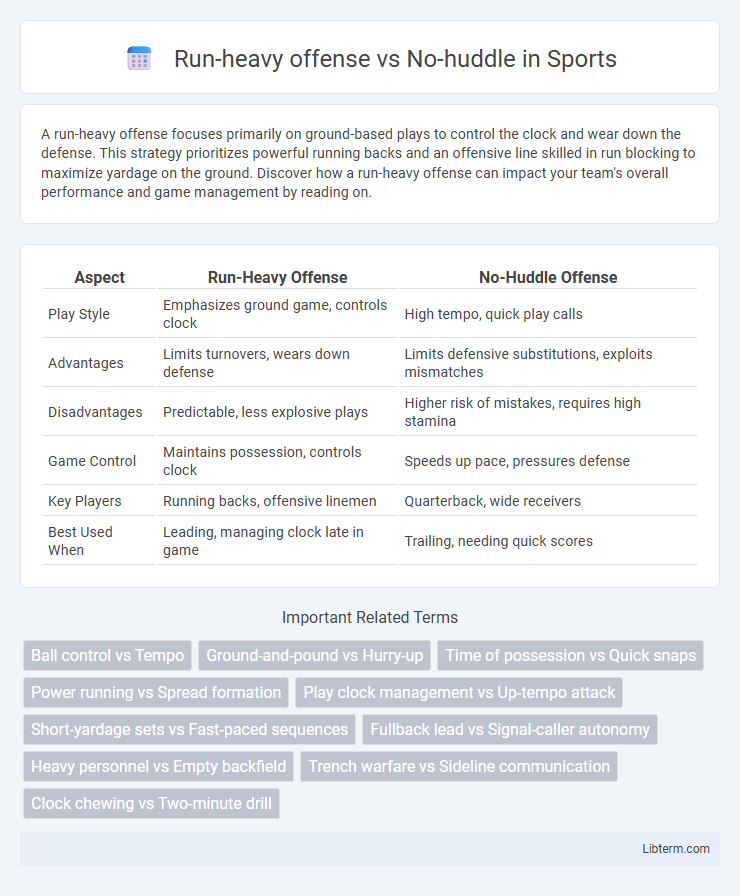A run-heavy offense focuses primarily on ground-based plays to control the clock and wear down the defense. This strategy prioritizes powerful running backs and an offensive line skilled in run blocking to maximize yardage on the ground. Discover how a run-heavy offense can impact your team's overall performance and game management by reading on.
Table of Comparison
| Aspect | Run-Heavy Offense | No-Huddle Offense |
|---|---|---|
| Play Style | Emphasizes ground game, controls clock | High tempo, quick play calls |
| Advantages | Limits turnovers, wears down defense | Limits defensive substitutions, exploits mismatches |
| Disadvantages | Predictable, less explosive plays | Higher risk of mistakes, requires high stamina |
| Game Control | Maintains possession, controls clock | Speeds up pace, pressures defense |
| Key Players | Running backs, offensive linemen | Quarterback, wide receivers |
| Best Used When | Leading, managing clock late in game | Trailing, needing quick scores |
Understanding Run-Heavy Offense: Principles and Strategies
Run-heavy offenses emphasize controlling the clock and physically dominating the line of scrimmage through a high volume of rushing plays, utilizing formations like the I-formation and single back sets to create power running lanes. Key strategies include utilizing versatile running backs who can break tackles, executing zone-blocking schemes to open cutback lanes, and incorporating play-action passes to exploit defensive aggression. Mastery of timing, blocking assignments, and downhill running principles ensures sustained drives and limits opponent possessions.
The No-Huddle Offense: Speed, Tempo, and Flexibility
The no-huddle offense emphasizes speed and tempo by minimizing time between plays, allowing teams to exploit defensive mismatches and prevent substitutions. This approach increases offensive flexibility through rapid adjustments and a varied play-calling strategy, keeping defenses off balance. The consistent high tempo can lead to defensive fatigue, enhancing opportunities for explosive plays in critical game moments.
Key Differences: Play Execution and Game Flow
Run-heavy offenses prioritize ground attacks, using a high volume of rushing plays to control the clock and wear down defenses, often resulting in a slower, more methodical game flow. No-huddle offenses accelerate the tempo by minimizing huddle time between plays, enabling rapid play execution and keeping defenses off balance with quick decision-making and fewer substitutions. The fundamental difference lies in run-heavy strategies emphasizing physical dominance and ball control, while no-huddle schemes focus on speed, adaptability, and maintaining momentum.
Impact on Time of Possession and Clock Management
A run-heavy offense typically controls the clock by maintaining long, sustained drives that consume significant time of possession, effectively limiting the opposing team's offensive opportunities. No-huddle offenses accelerate the pace of play, resulting in shorter possession times but increasing the total number of offensive plays and dictating the game's tempo. The strategic choice between these approaches influences clock management, with run-heavy schemes emphasizing steady clock depletion and no-huddle tactics prioritizing rapid play execution to maximize scoring chances.
Personnel Requirements: Physicality vs. Versatility
Run-heavy offenses demand physically imposing linemen and powerful running backs to consistently gain ground and control the line of scrimmage. In contrast, no-huddle offenses prioritize versatile personnel capable of quick adaptations, including agile receivers and quarterbacks with strong decision-making skills to maintain a fast tempo. The contrasting philosophies shape roster construction, with run-heavy systems emphasizing strength and endurance, while no-huddle schemes value speed, versatility, and situational awareness.
Defensive Adjustments Against Each Offense
Defenses facing a run-heavy offense prioritize stacking the box with linebackers and defensive linemen to clog running lanes and disrupt blocking schemes, often employing gap control and run fits to limit yardage. Against a no-huddle offense, defenses emphasize speed and communication, using nickel or dime packages to increase pass coverage while maintaining flexibility to adjust to rapid play calls and tempo changes. Defensive coordinators install versatile personnel who can shift quickly and disguise coverages, balancing run support with pass defense to counter the contrasting challenges posed by each offensive strategy.
Scoring Potential: Sustained Drives vs. Quick Strikes
Run-heavy offenses emphasize sustained drives by controlling the clock and methodically advancing the ball, increasing time of possession and limiting opponents' scoring opportunities. No-huddle offenses prioritize quick strikes, utilizing rapid plays and tempo to exploit defensive weaknesses and generate high-scoring, explosive drives. Scoring potential in a run-heavy system relies on consistent yardage gains and red-zone efficiency, while no-huddle offenses depend on speed, unpredictability, and capitalizing on defensive mismatches.
Fatigue Factors: Offensive and Defensive Implications
A run-heavy offense increases physical fatigue on defensive players due to sustained physical contact and time of possession, pressuring defenses to rotate personnel more frequently. Conversely, a no-huddle offense elevates mental and physical fatigue by accelerating the pace, reducing defensive substitutions and recovery time. Both schemes strategically exploit fatigue to compromise defensive effectiveness and create scoring opportunities.
Situational Effectiveness: When Each Offense Shines
Run-heavy offenses excel in short-yardage and clock-management situations by controlling the tempo and wearing down defenses with physical ground attacks. No-huddle offenses thrive in preventing defensive substitutions, exploiting mismatches, and maintaining a high tempo to capitalize on defensive fatigue and confusion. Teams often deploy run-heavy schemes in late-game leads to preserve time, while utilizing no-huddle offenses during comebacks or to exploit specific defensive weaknesses.
Modern Trends: Blending Run-Heavy and No-Huddle Concepts
Modern football offenses are increasingly blending run-heavy schemes with no-huddle approaches to maximize tempo and physicality. This fusion leverages the ball-control benefits and power running of run-heavy playbooks while maintaining the pace and unpredictability of no-huddle strategies, forcing defenses into quick decisions. Teams employing this hybrid approach often see enhanced time-of-possession control combined with explosive, high-tempo scoring drives, reflecting a significant trend in contemporary offensive playcalling.
Run-heavy offense Infographic

 libterm.com
libterm.com